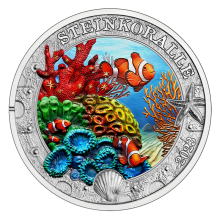





Austria 2023 3 euro colour collector coin glowing in UV - Stony coral from series "Luminous Marine Life"
This is the fifth 3 euro coin in the "Luminous Marine Life" series.
On the coin’s reverse, a wide band, reminiscent of an old-fashioned porthole frames an aquatic scene that features a coral reef. Stony corals are depicted in the top left of the scene, sea fans to the right, brain coral in the centre and sea anemones in the bottom left, while clownfish are dotted around the reef. When the coin is illuminated with UV light, the coral and sea anemones glow and change colour.
All 12 of the magical sea creatures in the Luminous Marine Life series are shown in silhouette on the coin’s obverse. Air bubbles up between them and a tail fin disappears beneath the waves to the right.
Scleractinia, also called stony corals or hard corals, are marine animals in the phylum Cnidaria that build themselves a hard skeleton. The individual animals are known as polyps and have a cylindrical body crowned by an oral disc in which a mouth is fringed with tentacles. Although some species are solitary, most are colonial. The founding polyp settles and starts to secrete calcium carbonate to protect its soft body. Solitary corals can be as much as 25 cm (10 in) across but in colonial species the polyps are usually only a few millimetres in diameter. These polyps reproduce asexually by budding, but remain attached to each other, forming a multi-polyp colony of clones with a common skeleton, which may be up to several metres in diameter or height according to species. The shape and appearance of each coral colony depends not only on the species, but also on its location, depth, the amount of water movement and other factors. Many shallow-water corals contain symbiont unicellular organisms known as zooxanthellae within their tissues. These give their colour to the coral which thus may vary in hue depending on what species of symbiont it contains. Stony corals are closely related to sea anemones, and like them are armed with stinging cells known as cnidocytes. Corals reproduce both sexually and asexually. Most species release gametes into the sea where fertilisation takes place, and the planula larvae drift as part of the plankton, but a few species brood their eggs. Asexual reproduction is mostly by fragmentation, when part of a colony becomes detached and reattaches elsewhere.
Stony corals occur in all the world's oceans. Much of the framework of modern coral reefs is formed by scleractinians. Reef-building or hermatypic corals are mostly colonial; most of these are zooxanthellate and are found in the shallow waters into which sunlight penetrates. Other corals that do not form reefs may be solitary or colonial; some of these occur at abyssal depths where no light reaches.
Data sheet